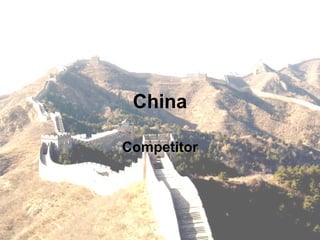
China
- 3. Yangzi River
- 4. Sunzi, The Art of War
- 5. The Duke of Zhou
- 6. Portrait of the First Emperor
- 8. Early History • Several “dynasties”. • 2000-214 BCE • Confucianism, Taoism, Legalism, Mohism all developed.
- 9. Painful Expansion • Empires concentrate power • Fight – Mongols – Koreans – Vietnamese – Assimilate many • Mongols eventually dominate.
- 10. Mongol Empire
- 11. Market Economy • Small scale industries grew up – Paper – Silk – Cotton – Porcelain – Gunpowder • Large Navy developed • Canals built • Army = 1 million
- 12. Qing Dynasty (1644 – 1911) • New Royal family uses brutal tactics • Social strife • Population explodes • Economy fails to keep up • European powers interfere in regional politics.
- 13. Opium Wars • British bought Chinese products. • Paid with silver, which depleted their supply. • Started selling opium to Chinese. • 1/3 adult population became addicts. • Empire forbid use of drug and sale. • British smuggled it illegally. • When China attempted to stop them, British military intervened.
- 14. Qin Falls • Internal wars erupt, encourage by Europe. • Empire becomes suspicious of foreign tools, customs, and technology. • Russia supports Muslim provinces to revolt. • Persecution of minority ethnic groups persist. • Taiping revolt led by self-proclaimed second son of Christian God. • 20-50 million dead.
- 15. Communism Rises • Boxer Rebellion – Chinese capture or kill Western immigrants and sympathizers. – Western armies retaliate • Qin dynasty agrees to Parliament and eventually abdicates. • Soviet Union backs a Communist Party which eventually falls under Mao Zedong. • Brief alliance formed with Nationalist under Chiang Kai- shek
- 16. Power Seized. • Shek turns on Communist. • They proceed on long march. • Parties reunited to defeat Japanese during WWII. • After WWII is over fighting resumes. • Communists win and Nationalists flee to Taiwan.
- 17. Great Leap Forward • 25,000 communes set up with 5,000 families each • Iron and steel production were thought essential. • Entire economy devoted toward industrialization. • 25-60 million starved to death. • Elimination of opponents and establishment of Mao personality cult.
- 19. Reforms started in the late 1970s • Phasing out of collectivized agriculture • Liberalization of prices • Fiscal decentralization • Increased autonomy for state enterprises • Foundation of a diversified banking • Development of stock markets • Rapid growth of the non-state sector • Opening to foreign trade and investment.
- 20. Positive Results • Ten-fold increase in GDP since 1978. • Second-largest economy in the world after the US • Economic development has generally been more rapid in coastal provinces. • 100 million internet users at the end of 2005. • Foreign investment remains strong • Urban growth and prosperity is phenomenal.
- 24. Negative Results • Tens of millions of workers laid off from state-owned enterprises • Migrants • New entrants to the work force • Corruption and other economic crimes • From 100 to 150 million surplus rural workers are adrift between the villages and the cities, many subsisting through part-time, low-paying jobs. • China is now one of the most rapidly aging countries in the world. • Deterioration in the environment – notably air pollution – soil erosion – steady fall of the water table especially in the North.
- 28. Statistics • GDP (purchasing power parity): $8.158 trillion (2005 est.) • GDP (official exchange rate): $1.833 trillion (2005 est.) • GDP - real growth rate: 9.2% (official data) (2005 est.) • GDP - per capita: purchasing power parity - $6,200 (2005 est.) • GDP - composition by sector: agriculture: 14.4% industry and construction: 53.1% services: 32.5% (2005 est.) • Labor force: 791.4 million (2005 est.) • Labor force - by occupation: agriculture 49%, industry 22%, services 29%
- 29. Conflict with USA • Nixon introduced trade with China to encourage alliance (and make USSR suspiciously jealous). • Trade has increased prosperity, especially of Communist Party. • Democracy has not taken foot. • Over 20% of our imports come from China. • Only 8% of their imports come from the USA. • Have developed missiles to reach West Coast. • Still claims to own Taiwan, our ally. • Continues to increase military budget.